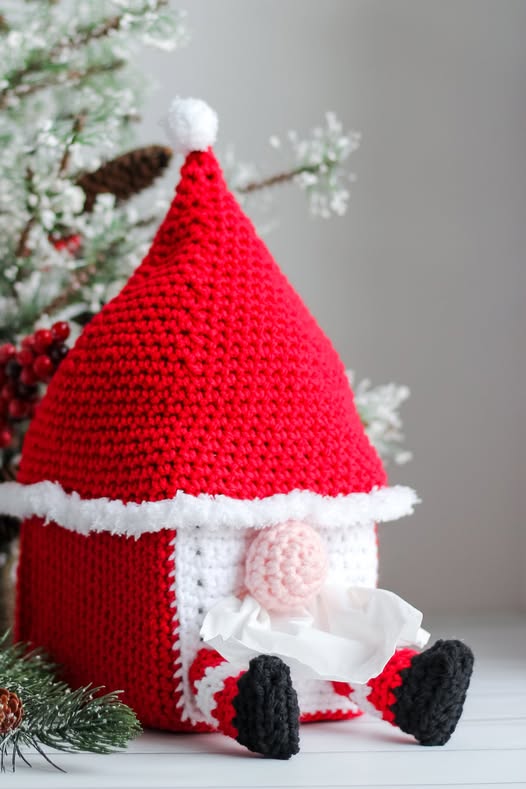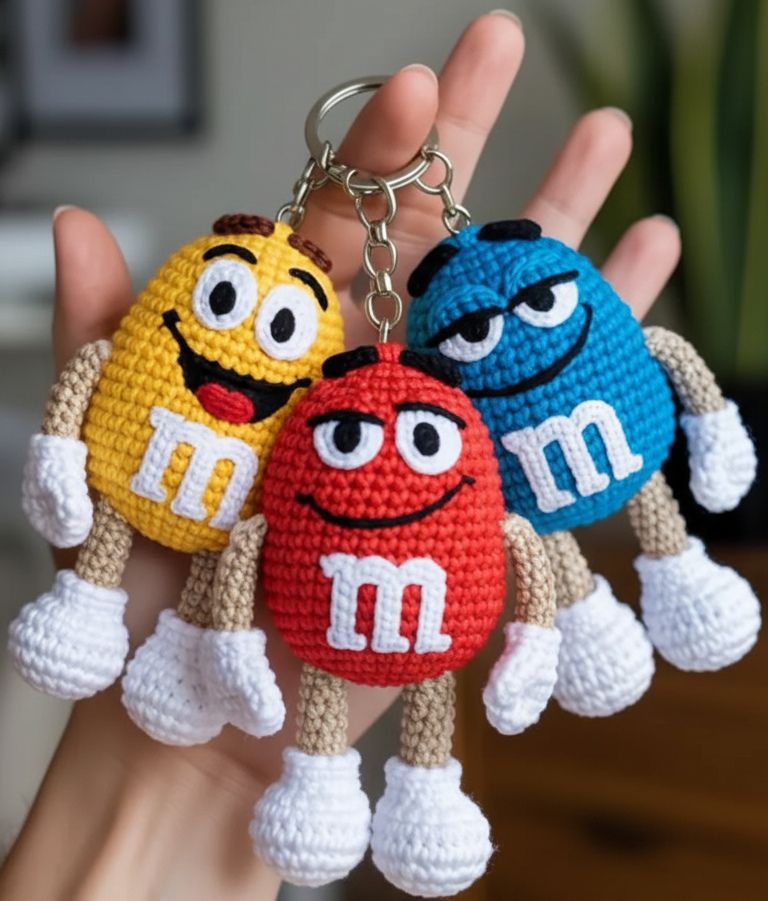

The Amigurumi M&M Keychains Free Pattern is a super-fun, quick, and adorable project that turns tiny balls of yarn into colorful candy-inspired keychains perfect for gifts, market stalls, or wallet-friendly craft fairs.
The idea behind the Amigurumi M&M Keychains Free Pattern is to capture the cute, rounded lentil shape of candy buttons while keeping construction straightforward.
Before you start crocheting your first candy charm from the Amigurumi M&M Keychains Free Pattern, think about the end use. If these are gifts for small children, swap safety eyes for embroidery and skip any small detachable beads.

To make several pieces with the Amigurumi M&M Keychains Free Pattern, gather these basic materials. Quality matters: choose yarn and hardware that are durable and kid-safe where relevant. You’ll need worsted weight (or DK for smaller charms) yarn in bright candy colors — red, yellow, blue, green, orange, brown or any palette you like. A 3.0–3.5 mm hook suits worsted/DK for a tidy amigurumi fabric; smaller hook = firmer stitches which is ideal for small toys. Polyester fiberfill stuffing, scissors, tapestry needle, stitch markers, and optional safety eyes (if you’re making faces) are essential. For keychain hardware, use small split rings and lobster clasps or small keychain rings; a short length of strong cotton yarn or a metal screw-eye (sewn or screwed into an internal loop before final seam) will anchor the hardware. If you’ll embroider letters (like an “M” or initials), have white or contrasting embroidery thread and a small embroidery needle. For safety, especially for baby items, use embroidered details instead of glued-on beads.
This pattern describes how to create one Amigurumi M&M Keychains Free Pattern candy. It makes two matching domes that are joined into a flattened lentil shape. Keep a stitch marker on the first stitch of each round. Work in continuous rounds unless otherwise noted. Gauge is flexible; finished size with worsted yarn and a 3.5 mm hook will be roughly 1.75–2 inches across. Adjust by using a smaller hook/ finer yarn for tiny charms or thicker yarn for larger keychains.
Dome — Make 2 (leave last round open for stuffing, we’ll join them)
R1: Magic ring, 6 sc (6)
R2: inc around (12)
R3: (sc, inc) x 6 (18)
R4: (2 sc, inc) x 6 (24)
R5: (3 sc, inc) x 6 (30)
R6–R8: sc around (30) — these rounds give the dome height (adjust rounds for thicker or thinner candies)
R9: (3 sc, dec) x 6 — 24 sts
R10: sc around (24) — leave this round as the outer edge for sewing; do not decrease further — fasten off leaving long tail for sewing. Repeat to make a second dome in the same color.
Assembly for this Amigurumi M&M Keychains Free Pattern
Place the two domes right sides together (i.e., the right surface of each dome facing outward when joined). With your long tail and tapestry needle, whipstitch or mattress stitch around the R10 edge to join them, but stop when the seam is about 80% complete. Turn right side out through the remaining gap, stuff firmly but not overstuffed (you want a slightly squishy lentil shape), then finish sewing the gap closed. Before you finish the seam completely, slip the loop of your split-ring attachment or a short yarn loop (double knotted and buried) into the top seam so the keyring can be attached through it, then complete the seam and securely weave in the ends.
Optional surface decoration for the Amigurumi M&M Keychains Free Pattern
If you want the classic candy look, embroider a small white lowercase “m” or a circular white badge using embroidery thread after the charm is finished. If you prefer not to reproduce any brand logos, stitch a simple white dot or a tiny heart for personalization. Another option is to glue or sew a small felt circle as a badge. For safety and durability, embroidery is best.
When adding hardware, keep two things in mind: durability and safety. For lifelong use, sew a short-length yarn loop into the seam, then knot it and reinforce by sewing over it multiple times before closing the final stitches. Slide a metal split ring onto that loop and attach a lobster clasp if you wish. If you choose to use a metal screw-eye, test it thoroughly — insert and secure it into a small wooden dowel core or thread it into a short length of tightly twisted yarn and sew in place so it won’t pull through the soft amigurumi fabric. For items meant for children under three, avoid metal parts and small beads — make the charm purely crocheted with embroidered motifs. When selling or gifting, label them appropriately if small parts are used. The Amigurumi M&M Keychains Free Pattern is ideal for adults and older kids, but with adjustments (embroidered details only), they can be made toddler-safe.
The Amigurumi M&M Keychains Free Pattern is a perfect base for playful variations. Make a rainbow set for a birthday party favor, stitch initials for bridesmaid gifts, or color-coordinate with sports team hues as handmade merch. Create seasonal batches — pastel eggs for spring, jewel tones for winter holidays, or bright neon for summer markets. For a novelty twist, add tiny faces to turn them into character keychains; a little felt hat or crocheted bow becomes an instant personality upgrade. Combine several charms on a single ring to make a colorful bag charm or zipper pull. If you’re selling, package them in small organza bags with recycled card tags describing color name and fiber content — it makes them feel boutique-ready. The Amigurumi M&M Keychains Free Pattern also lends itself to charity crafting: these small, quick projects are great for community group meets or craft-a-thons where many hands can produce a lot of cheerful items quickly.
Q: Is this pattern beginner-friendly?
A: Yes. The stitches are basic single crochets, increases, and decreases. Beginners comfortable with single crochet in the round can complete a charm after a bit of practice.
Q: How long does one keychain take?
A: Once you’re comfortable with the rounds and assembly, expect 30–60 minutes per charm. First-time makers might take longer.
Q: What yarn works best?
A: Smooth, worsted-weight cotton or a cotton/acrylic blend gives crisp stitches and bright colors. Use a slightly smaller hook than the yarn recommends for tight stitches to keep stuffing from peeking through.
Q: Can I sell items made from this free pattern?
A: Yes. Handmade items created from free patterns are usually sold by crafters, but it’s good practice to credit the pattern source and avoid using trademarked logos unless you have permission. For example, prefer embroidered dots or initials instead of trademarked brand icons.
Q: How do I clean the keychains?
A: Hand wash gently in cool water and reshape while damp. Air dry flat. Avoid machine washing if hardware is attached; remove hardware first or spot-clean.
Q: Are there size adjustments?
A: Yes. Use thinner yarn and smaller hooks for mini charms, or thicker yarn and larger hooks for larger pillows/ornaments. Adjust dome rounds to change thickness.
Q: What about embroidery of logos (like an ‘M’)?
A: For personal use it’s fine, but if selling, avoid reproducing trademarks exactly. Instead, use a simple sewn dot or initials to personalize.
Q: Can I make them toddler-safe?
A: Yes — use embroidered details only, skip all metal attachments, and securely sew loops into the seam so nothing detaches.
The Amigurumi M&M Keychains Free Pattern is a joyful, small-scale project that offers big payoff: bright colors, quick completion, and endless customization.
Whether you’re making a handful as heartfelt gifts, dozens for a craft sale, or a small fleet of bag charms to match wardrobes and moods, this pattern delivers.
Keep your stitches tight, stuff evenly, secure your hardware properly, and have fun experimenting with colorways and tiny embellishments. These little candy-inspired charms are the perfect example of crochet’s power to turn humble yarn into charming, portable art.
If you try the Amigurumi M&M Keychains Free Pattern, I’d love to hear how your color choices turned out, what variations you invented, and any tips you’d share — leave your honest thoughts and suggestions so we can all make even sweeter handcrafted creations.